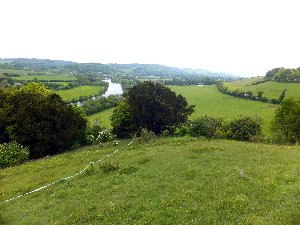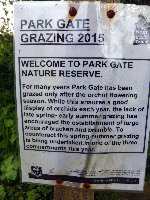|
21st - 28th May 2016 Chilterns, Kent and Sussex trip
A week away to visit many of the exotic sites where orchids absent or rare north of the Thames grow - at least thatís the plan. Unfortunately the plans are rather upset when I take a tumble at Park Gate Down and land rather awkwardly. An afternoon in Ashford A&E rules out any broken bones and provides me with a pair of sticks to get around with. However some site visits planned now have to be shelved; Bonsai Bank in Kent and Castle Hill near Brighton would have mean a long hobble to species seen elsewhere, while Wye looks to have potential for a further tumble. Lessons have been learned - orchideering can be dangerous but not so dangerous that we need to get kitted out in hi-vis jackets. The Temple Ewell reserve is visited, but is such a dogís toilet that we leave in disgust without finding any orchids. Shame on the guilty dog walkers!
Itís a shame that the restrictions of time, circumstances and so much more to see meant we only visit well-trodden sites. Traveling from from location to another revealed so many potential orchid sites and footpaths. It would have been nice to find some new gems, so perhaps another year.
Homefield Woods, 21st May 2016 (SU 8142486769)
I visited Homefield in Buckinghamshire two years ago about three weeks later in the year and am hoping that the Military Orchids will be in prime condition this time ..... and indeed they are. Numbers are about the same as last time, but I now see that there is a bit of colour variety there with some brightly coloured and some rather pale. I am surprised that there are no other enthusiasts looking at the orchids despite it being a fine Saturday morning. I am also surprised to see that those illustrated in Harrap are not so much purple as a dullish burgundy colour. Is this a photographic anomaly, a printing anomaly, or because those pictured in the book are from the Suffolk colony? Homefield was where the Military Orchids were first rediscovered in Britain in the 1940s, after being thought to be extinct. They are now looked after.
A quick search for the Greater Butterfly Orchid seen in the top left corner of the meadow reveals nothing, and of the other species seen previously only the Common Twayblades are in flower. The Common Spottedís flower spikes are just appearing, but there seems little point in searching for Pyramidal Orchids, or Bee Orchids. In 2014 I was too late for the White Helleborines and this time just a bit too early - just flower buds to be seen.
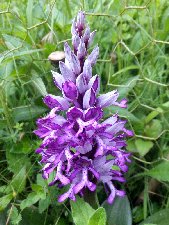 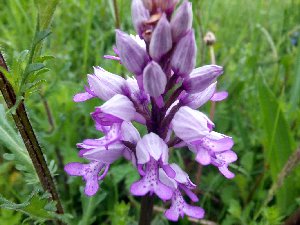 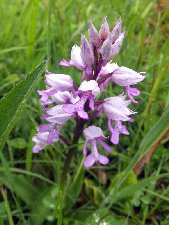
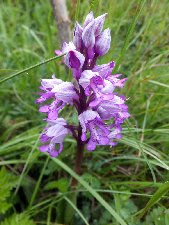 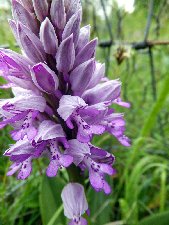 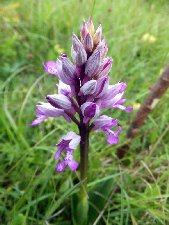
Military Orchids
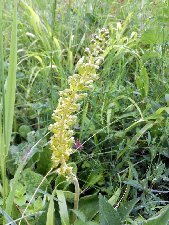 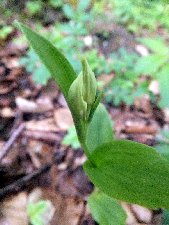
Twayblade and White Helleborine
Hartslock Reserve 21st May 2016 (SU 6171979458)
|
A new place to visit; one that is famous for one particular orchid. The Lady x Monkey Orchid (O. xangusticruris) grows on the appropriately named Ďorchid slopeí and now grows in huge numbers. They are a sight to be seen, even if ropes have been put up to help prevent trampling. This is better for photography than the cages used at Homefield over the Military Orchids as there are more than enough fine examples alongside the walkways. Actually the first orchid to be seen today is a Monkey Orchid, and this was growing on a different slope. The Monkeys are not as numerous as the hybrids but easy enough to spot and even identify from a distance. They seem small, pale and delicate compared to the more vigourous and showy hybrids. There are apparently only two Lady Orchids growing on the site and this year both have had their flowers picked or nibbled away. We donít stay long enough to have a good look around (we still have to get to Kent after a visit to Silchester Roman Walls), but do find Common Spotteds nearly in flower, and some White Helleborines a day or two off opening properly.
|
The view of the Thames from the orchid slope. |
|
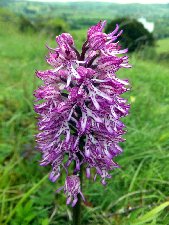 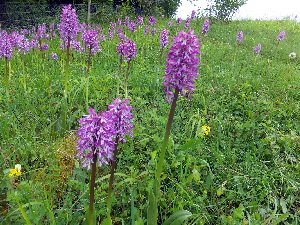 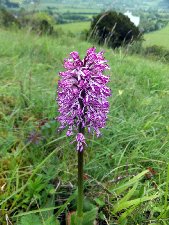
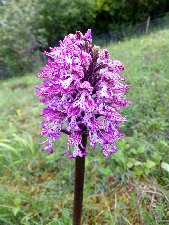 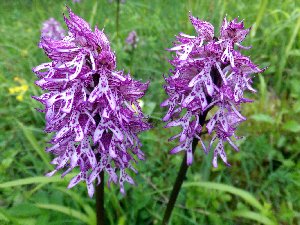 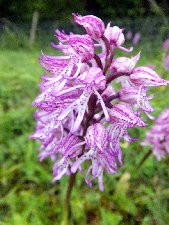
The Lady x Monkey hybrids
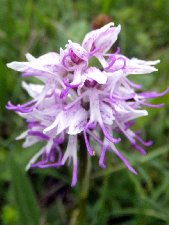 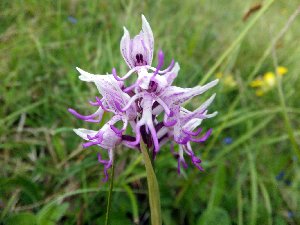 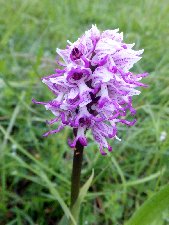 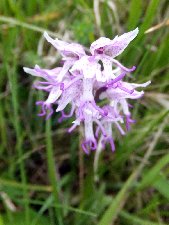
The Monkey Orchids
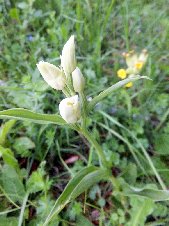 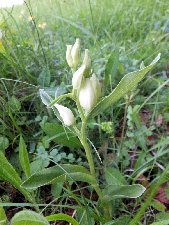
the White Helleborines
The Lady Monkey hybrids have been confirmed as the Lady Orchid being the ovule parent and the Monkey Orchid being the pollen parent. Usually hybrids tend towards the ovule parent in appearance, possibly because of the additional cytoplasmic contribution. However these look more like the Monkey Orchid, and it was originally thought that they may have been Military Orchids, being so anthropomorphic. However, a few do look a bit more Lady-like, and the bottom left photo shows flowers where the Ďlegsí are much less defined than the others. Incidentally, the two Lady Orchids on site have been shown to have a continental origin rather than the genetic make-up of the Kent orchids. There is the remote chance of wind blown seed geminating here, but human introduction by seed or bulb is seen as most likely. The hybrids appeared in 2008, four years after the Ladys first flowered, and in their first year there were only seven. Since then many more have appeared. The Chiltern Monkey Orchids are genetically, and some say morphologically distinct, to those in the two Kent sites.
Samphire Hoe. 22nd May 2016 (TR 2927839164)
|
A new day and a series of sites to visit, after a nice early trip on the RHDR - no sign of orchids at Dungeness by the way. I have been to Samphire Hoe before, a few weeks later, and found only Common Spotted Orchids. This time though, we are just in time to see the Early Spider Orchids. I must emphasis just because in virtually every case it is the final flower on each plant that is out or beginning to fade. They are growing in large numbers around the back car park and along the path that runs next to the railway beneath the cliffs. I am pleased to read that that the ESOs have colonised the Hoe rather than being planted or artificially seeded. There must be a decent sized colony on the cliffs above. This is reflected (see pictures) in the variations in the speculum shape (mainly a sort of Greek Π shape) and the colours and form of the petals. Summerhayes repeatedly mentions how short this orchid grows, but a good few specimens here were over 25cm tall.
|
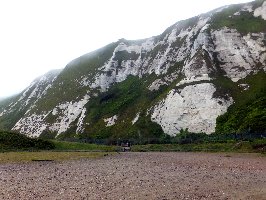
The Early Spider area and the cliffs, just as a sea mist was descending at the top.
|
|
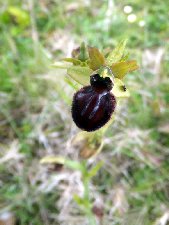 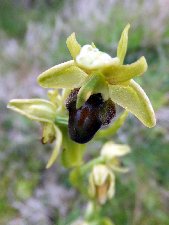 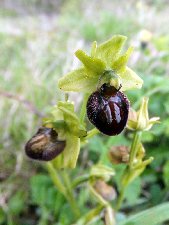 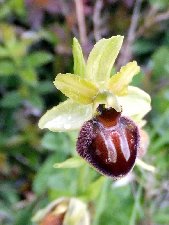 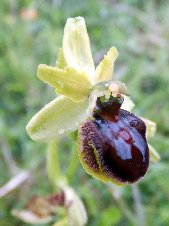
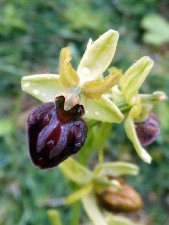 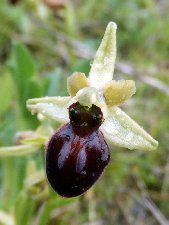 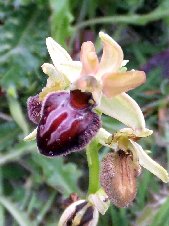 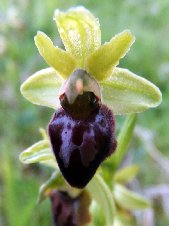 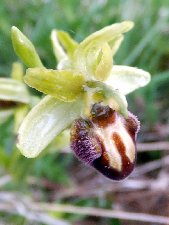
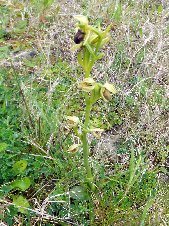 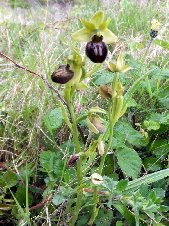 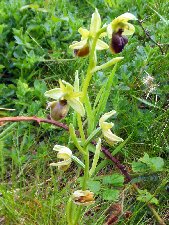 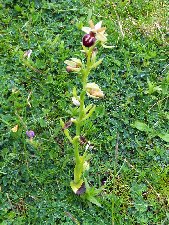 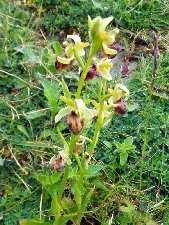
near Lydden, 22nd May 2016
|
A roadside site previously visited and worth seeing again for the Man Orchids. Last year I saw this species growing in Warwickshire and those specimens virtually lacked any reddish colouration. The Lydden Men make up for that lack of colour. However they donít look as impressive as they should, and this may be due to the fact that, though this visit is earlier in the year, the grass and other vegetation seems taller and more abundant - see photos. Rewarding, nevertheless.
In 2013 there was a protective cage for a presumed orchid on the central road reservation. I was hoping it would be in flower (whatever it is) this year, but it has disappeared. Did the cage highlight the fact that a rare orchid grew there?
|
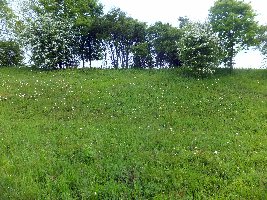
The bank on which the Man Orchids grow shows how the orchids are well hidden despite their height.
|
|
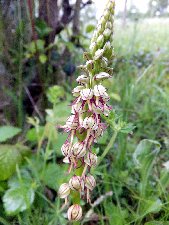 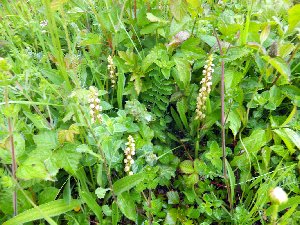 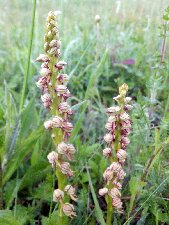
Park Gate Down, 22 May 2016 (TR 1679845862)
|
This is where I have my accident, but not until we are leaving. I have been here before, again later in the year, and several years ago. This time, not only does there seem to be more Monkey Orchids in flower, but they are in much better condition. I am sure that previously they only appeared in the second or middle field, but today they are everywhere, and that includes high up the slope and lower down. I gave up counting at 100. Harrap states that the Kentish Monkeys, compared to those from the Chilterns, are sturdier, have bigger leaves, and a richer colouration. Comparing to those from Hartslock, this does seem to be the case. Though the Park Gate population was seeded it was from the other Kent site near Faversham. My photos again show a more purple colour to the flowers than the more brownish-purple shown in Harrap. Meanwhile Summerhayes states that this species is unusual in that the topmost flowers open first. This does not seem to be the case either here or at Hartslock.
|
|
|
If anything, they seem to open altogether creating a jumble of monkeys, with some twisted upside down, and all curly legs and arms. Most untidy sometimes! The change in reserve management in 2015 seems to have had a positive effect on the Monkey population.
|
|
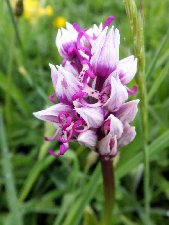 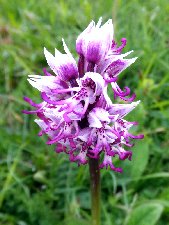 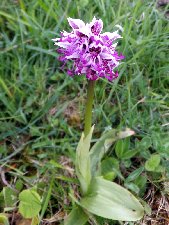 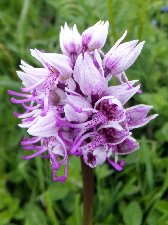 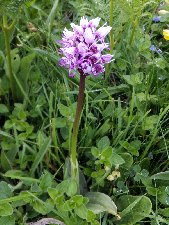
Because we are here earlier in the year than the previous visit, the Early Purple Orchids are also prominent, even if they are coming to an end for 2016. They show a range of colouration from a rich purple to a paler pinker shade. There are the inevitable Common Twayblades in flower, but not a sign of the Chalk Fragrants that greeted me on entry to the reserve last time I was there.
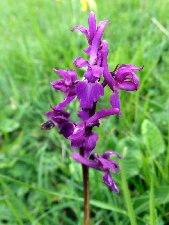 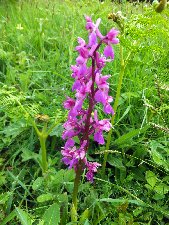 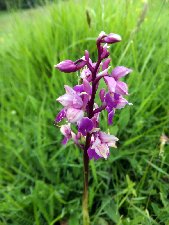 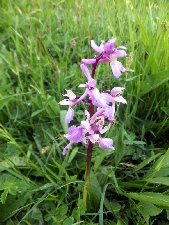 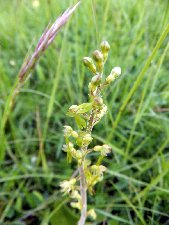
near Stelling Minnis,22nd May 2016
This narrow wooded country lane is close to Park Gate, and is as much a test of my injured foot as yet another orchid site. When I was here two years ago the Lady Orchids were beginning to go over a bit, but this year they are just coming out. And a nice display they are too. We count 23 flower spikes over 20 metres of road. Some have quite paler spots on their dresses and some have much trimmer waists. With a small colony like this there is probably enough variation in the flowers to identify individual plants from year to year. I notice that Summerhayes also calls this species the Brown-winged Orchid; a term I have not seen before, and really does not do them justice.
In 2014 only Lady Orchids were seen, but this year there are both Early Purple Orchids (purple and pink forms) and Common Twayblades in flower, and some rather obvious Common Spotted Orchids.
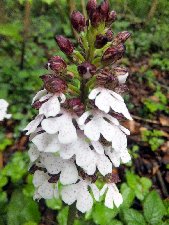 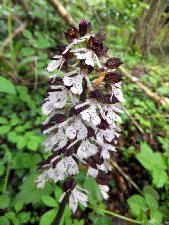 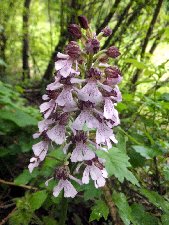 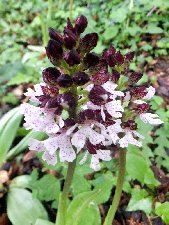 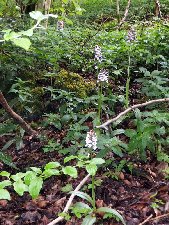
Lady Orchids
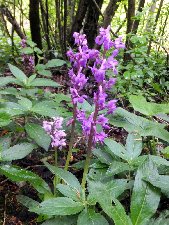 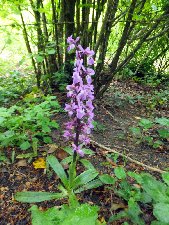 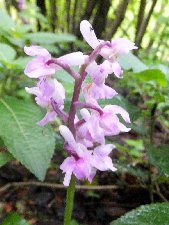
Early Purple Orchids
Yockletts Bank, 23rd May 2016 (TR 1251747813)
I was told before I left that Yockletts is a delight, and it is. While I didnít feel that I could go too far with my injury, I really didnít need to. From the road through the middle of the woodland and looking downhill I take the left hand side, and it is not long before, in a bit of a clearing, there are both Fly Orchids and Lady Orchids. The Lady Orchids catch the eye, but luckily we see the Fly Orchids before there are any accidents. So easy on a site like this with an delicate unobtrusive species in low light. More of both species are found further along the path along with more Early Purple Orchids and Common Twayblades. A quick check along the woodland path on the other side of the road found more Lady Orchids; these had very pale (almost missable) papillae on the labellum. There was no sign of the Greater Butterfly Orchids seen five years ago.
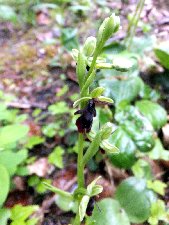 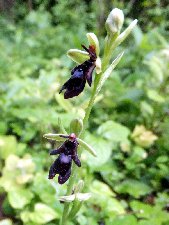 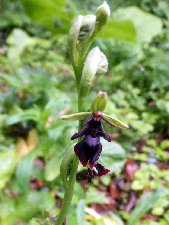 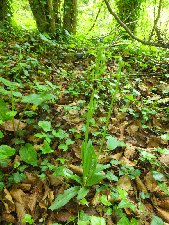 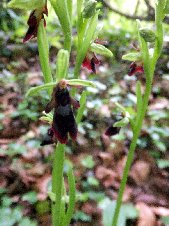
The Fly Orchids
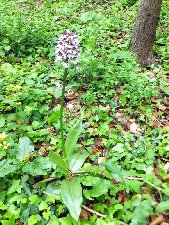 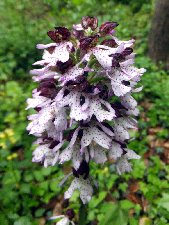 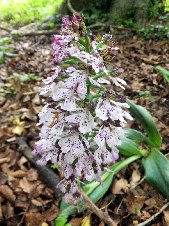 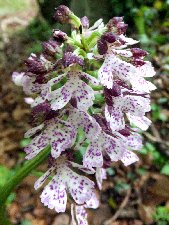 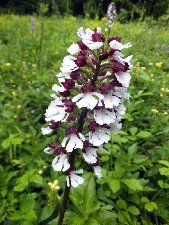
Lady Orchids - nearly spotless at right.
Within the Fly Orchid population there us one plant where the labellae are exceptionally broad and ended with a convex shape, as opposed to the normal pointed end. This seems to fit, as described in Harrap, with Var. subbombifera. In the absence of any other possibility I have to adopt this naming.
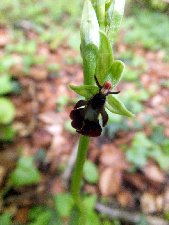
There are also helleborines growing here and it seems that there are possibly three different species judging from the quite differing appearances of the leaves. Only one has a flower, and that is not open, but it is white - from the leaves I would go for White Helleborines. So could the other two be Broad-leaved Helleborines and Sword-leaved Helleborines?
|
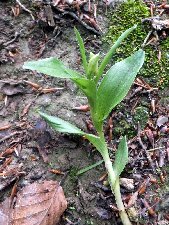
|
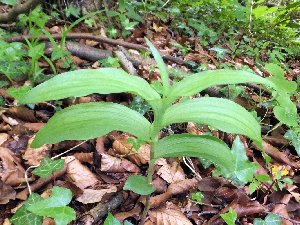
|
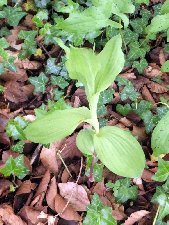
|
|
The White Helleborine with flower
close to opening
|
The leaf shape and arrangement of this plant is similar to the Sword-leaved Helleborine, if a bit broader than one would expect.
|
The growth on plants like this is behind the other two, and the leaf colour is different. Broad-leaved?
|
|
Beachy Head. 24 May 2016 (TV 5818095595)
.... or more precisely along the roadside approaching Beachy Head from Birling Gap. There are a number of clumps of Early Purple Orchids. At the top there is a notice board declaring that Bee Orchids may be found there, but they would say that. In fairness though, there is no reason why they couldnít grow there.
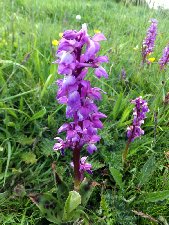 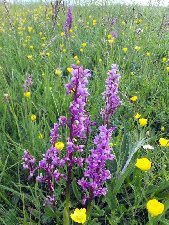
Caburn Bottom, 22nd May 2016 (TQ 4423709235)
|
As we approach Lewes after leaving Kent, Mount Caburn looms into view and it looks a bit of a daunting prospect to ascend on sticks. So we leave the visit till the last full day in the area, but in fact the climb is not as bad as first appearances. In fact, because I am so slow, I am not as puffed as I would have been. However, the slopes of Caburn Bottom are rather steep and I have to take great care not to do a repeat performance of Park Gate. The first orchid sighted is in fact a Chalk Fragrant Orchid, not quite out, but recognisable as such. This year is reportedly not a great year for Burnt tip Orchids, and so it proves. We do find a handful soon enough, and having got photos in the bag make a slow retreat. One, viewed later, shows a bit of an atypical example. It has very pale sepals and very pale spots, while the Ďbodyí seems slim compared to all the other examples. It may be just at the end of its flowering period. Though small the BTOs are easy enough to spot once you are within 10 foot of a flower. The colours do seem to stand out in the shorter grass.
|
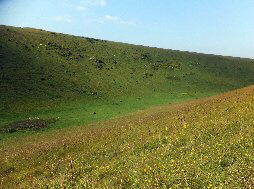
The part of Caburn Bottom where Burnt Tip Orchids may be found
|
|
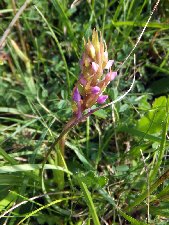 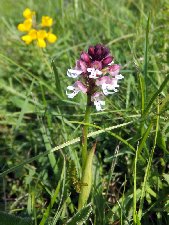 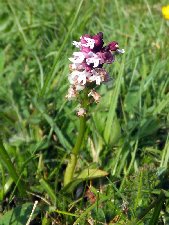 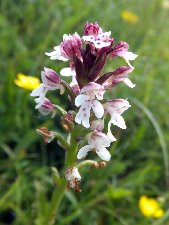 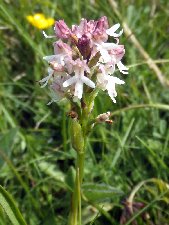
The Fragrant Orchid (left) and Burnt Tips
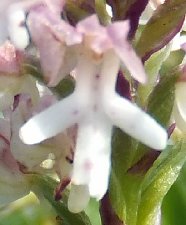 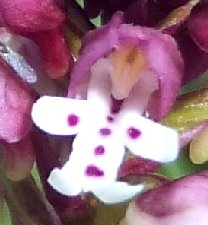
The pale and a more normal example close up.
Buckholt Woods,27th May 2016 (SO 8937113080)
Looking at the maps it seems that the journey from Brighton to north Wales could be extended by a mere 20 miles by a diversion through Gloucestershire. Here we revisit these woods. Last year the Birdís-nest Orchids were plentiful but had gone over in July. This May sees them just opening. Itís not far from the reserve car park at Cranage to where they are plentiful. You have to be careful not to trample them even on the paths - they love old dark and deciduous woodland like this. What we have noticed over the two visits is how sometimes they can be seen in a ring and sometimes in line, growing two foot apart. Last yearís dry seed heads are visible still, and what you donít see is this yearís plants growing alongside like you can do with other species. A comment made in reference to a North Wales location stated that they didnít come up in the same places from year to year. A review of the photos has reveled that one plant is a probable var. pallida, though this would not be confirmed without the flower opening.
There are also some non-flowering helleborines dotted around, and eventually we find one about to flower, and this reveals them to be White Helleborines. This species seems to be remarkably consistent in being just about to come out at the four sites we have seen them this week. Not one single properly open flower. A return to the Leckhampton site for the White Helleborines there is ruled out due to a partial road closure by the Air Balloon pub causing long tailbacks. We have avoided these by taking the single-track roads across to Buckholt.
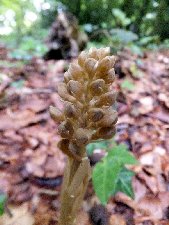 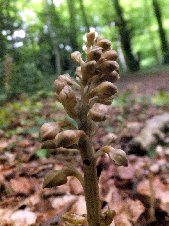 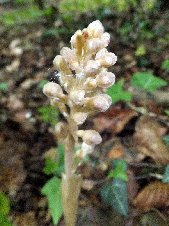 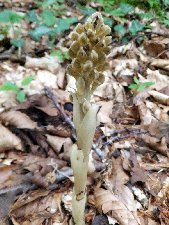 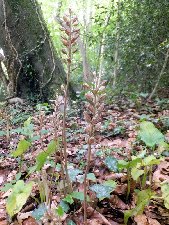
The Birdís-nest Orchids with the var. pallida in the centre
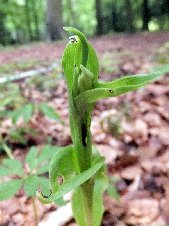 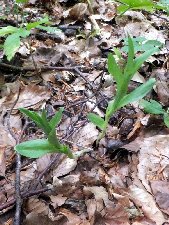
The presumed White Helleborines
    
|
























